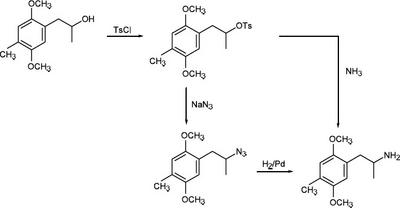
The picture above shows a few of the steps in the creation of amphetamines. In these steps, tosyl chloride is added to (2,5-dimethoxyl-4-methylphenyl)-2-propanol to create the tosylate. After this step, the reaction can proceed in one of two ways. If the chirality of the amphetamine is not important, ammonia is added to the tosylate to give 2,5-dimethoxy-4-methylamphetamine. This reaction has an 80% yield, but has a racemic mixture of products because it is thought to be an SN1 reaction. If the chirality is important, the tosylate is converted into an azide with sodium azide, then hydrogenated using a paladium catalyst to form 2,5-dimethoxy-4-methylamphetamine. Forming the amphetamine using this method gives a final yield of about 77%. The chirality of the original alcohol is inverted by the tosylation, so reacting an (S)-alcohol with the tosyl-azide-hydrogen sequence would give an (R)-amphetamine, and vice versa.
For the full text of the article describing this process, see this report.
Wednesday, August 6, 2008
Creating Amphetamines by Tosylation of Alcohols chymistry
Labels:
chemistry info
Subscribe to:
Post Comments (Atom)
No comments:
Post a Comment